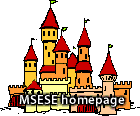|
Convergent
Boundaries
Places where plates crash or crunch together are called convergent
boundaries. Plates only move a few centimeters each year, so collisions
are very slow and last millions of years. Even though plate collisions
take a long time, lots of interesting things happen. For example,
in the drawing above, an oceanic plate has crashed into a continental
plate. Looking at this drawing of two plates colliding is like looking
at a single frame in a slow-motion movie of two cars crashing into
each other. Just as the front ends of cars fold and bend in a collision,
so do the "front ends" of colliding plates. The edge of
the continental plate in the drawing has folded into a huge mountain
range, while the edge of the oceanic plate has bent downward and
dug deep into the Earth. A trench has formed at the bend. All that
folding and bending makes rock in both plates break and slip, causing
earthquakes. As the edge of the oceanic plate digs into Earth's
hot interior, some of the rock in it melts. The melted rock rises
up through the continental plate, causing more earthquakes on its
way up, and forming volcanic eruptions where it finally reaches
the surface. An example of this type of collision is found on the
west coast of South America where the oceanic Nazca Plate is crashing
into the continent of South America. The crash formed the Andes
Mountains, the long string of volcanoes along the mountain crest,
and the deep trench off the coast in the Pacific Ocean.
Are They
Dangerous Places to Live?
Mountains, earthquakes, and volcanoes form where plates collide.
Millions of people live in and visit the beautiful mountain ranges
being built by plate collisions. For example, the Rockies in North
America, the Alps in Europe, the Pontic Mountains in Turkey, the
Zagros Mountains in Iran, and the Himalayas in central Asia were
formed by plate collisions. Each year, thousands of people are killed
by earthquakes and volcanic eruptions in those mountains. Occasionally,
big eruptions or earthquakes kill large numbers of people. In 1883
an eruption of Krakatau volcano in Indonesia killed 37,000 people.
In 1983 an eruption-caused mudslide on Nevada del Ruiz in Columbia
killed 25,000 people. In 1976, an earthquake in Tangshan, China
killed an astounding 750,000 people.
On the other
hand, earthquakes and volcanoes occurring in areas where few people
live harm no one. If we choose to live near convergent plate boundaries,
we can build buildings that can resist earthquakes, and we can evacuate
areas around volcanoes when they threaten to erupt. Yes, convergent
boundaries are dangerous places to live, but with preparation and
watchfulness, the danger can be lessened somewhat.
Back
| Next
|











